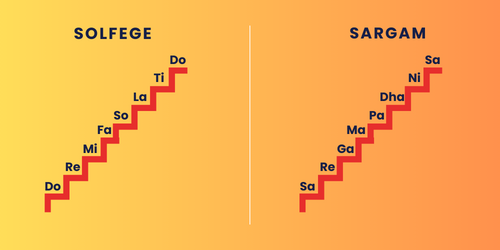
Table of Contents
Ever wondered why athletes stretch their bodies before a game? To warm up and build strength, right?
Similarly, as singers, we must warm up our vocal cords and develop a strong foundation before singing. That's where Solfa practice comes in.
If you've ever been in a music class, you must’ve heard the terms ‘solfa’ or ‘solfege’. It's the most effective exercise for singers at any level, beginner or advanced. Whether you're struggling with hitting the right notes, dealing with voice cracks, or trying to improve your breath control, Solfa exercises can help you get there.
What is Solfa?
Sounds like medicine, right? Well, you can call it that as it cures your singing problems. It's a method of teaching and learning music using syllables to represent different frequencies for every pitch/note.
You must be familiar with the 7 musical notes in singing:
Do Re Mi Fa So La Ti Do
Or, as it is known as sargam in Indian Classical singing:
Sa Re Ga Ma Pa Dha Ni Sa

These 7 notes are the foundation of learning to sing. And we must build a strong foundation to be truly pitch-perfect.
So, are you ready to learn the perfect-pitch singing? Let’s begin!!!
Activity 1Practice singing “Do Re Mi Fa So La Ti Do” for 5 minutes daily until you can sing it in the correct pitch. Use an online piano/ tanpura from Spardha's free music tools for the reference pitch.
Activity 2Practicing different solfa patterns enables you to understand the note placement better.
Practice these 6 solfa exercises daily for 10 minutes:
1. do re mi re | re mi fa mi | so - re mi | do - - - ||
2. do re mi - | re mi fa - | sol - fa mi re | do - - - ||
3. do re mi fa | so fa mi re | do - so - | do - - - ||
4. do re mi mi | re mi fa fa | mi fa so so | la ti do - ||
5. do ti la so | fa mi re - | do re mi fa | so la ti do ||
6. do mi re - | do mi re - | so fa mi re | do - - - ||
These solfa patterns are just the beginning; there are endless possibilities with these notes.
If you struggle with them or have any questions, we would suggest signing up for a FREE TRIAL SESSION with our Western Vocal faculty. Get personalized guidance and clarity on your doubts during this trial session.

Benefits of Solfa Singing
1. Enhanced Ear TrainingHave you ever noticed that while singing, you first hear the notes in your head before you attempt to hit them? This is because listening is fundamental to singing. Once you can listen clearly, it becomes easier to notice and reproduce subtle musical details such as pitch, rhythm, melody, and harmony with greater accuracy and sensitivity. Solfa practices prioritize ear training, which eventually enhances your vocal abilities.
Learn more about ear training.

In Solfa, each syllable represents a note. So, when you practice these syllables, you're really getting to know each note better. If you regularly practice solfa, you develop an understanding of the note placement. This makes it easier to hit the right pitch, stay in tune, and shape your singing, adding depth to your interpretation and making your performances more expressive.
3. Easy Sight Singing:Sight-singing is the ability to read and sing a piece of music without having heard it before. It involves interpreting the notes, rhythms, and other musical elements directly from the sheet music and producing them vocally. Just like in Solfa, where every note has a syllable to denote a frequency, in sight-singing, every note has a unique symbol. Not only does sheet music contain notes, but also lyrics, pauses, modulations, dynamics, and articulations, etc., making it easier to learn and sing quickly.
4. Collaborative Skills:If music is the universal language, Solfa is its dialect. Imagine how difficult, confusing, and time-consuming it would be to explain everything through singing to fellow musicians. That's why terms like tempo, rhythm, chords, key signature, and time signatures, etc., are used to convey music in an easy and effective way through sheet music. When everything is on the sheet, everyone is on the same page, which helps you collaborate, making it simpler to sing or play together in ensembles.
5. Versatility:Whether it's classical, jazz, or popular songs, understanding the context and styles of each genre is crucial in music. When you practice the basics, you are laying a foundation for every kind of musical genre, as every piece of music that ever existed or will exist consists of these notes in random permutation and combination. In that way, Solfa helps in adapting to various musical contexts and styles, making it an easy and effective method for learning singing, playing instruments, and understanding music theory.
Now that you've read about it, it's time to master the art by practicing Solfa. Everything might feel new and strange at first, but if you don't start, you'll never learn. Start today!
Stay spirited, keep singing!
Pooja Sharma
Western Vocals Teacher
Spardha School of Music
